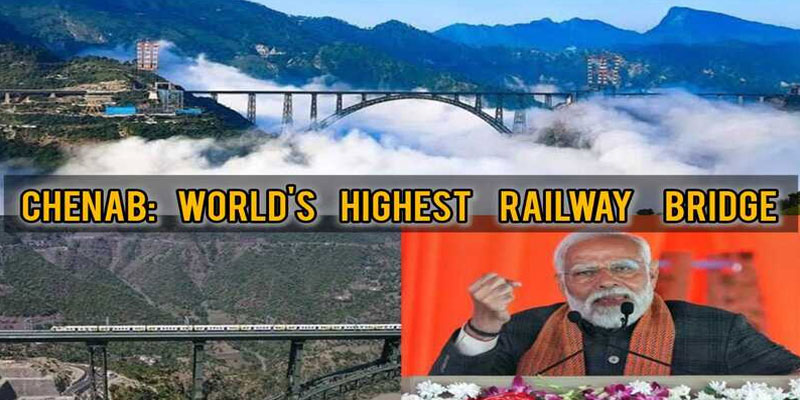A Two-Decade Wait Ends: Chenab Bridge Set to Transform Kashmir
The people of Jammu and Kashmir are going to get the Chenab Bridge after waiting for two long decades. On June 6, Prime Minister Narendra Modi will inaugurate the world’s highest railway arch bridge—a colossal symbol of engineering excellence and national integration. Union Minister Jitendra Singh confirmed the milestone on social media, calling it a “glorious symbol of New India.”
Spanning the mighty Chenab River in Reasi district, this 1.31-kilometre bridge connects the towns of Bakkal and Kauri and forms a critical part of the Udhampur-Srinagar-Baramulla Railway Link (USBRL). At 359 meters above the riverbed—35 meters taller than the Eiffel Tower—it will be the highest railway bridge on Earth.
Why Chenab Bridge Matters
This isn't just a bridge; it's a lifeline. For the people of Jammu and Kashmir, the Chenab Bridge represents more than just connectivity—it embodies long-awaited economic opportunity, reliable transport, and a direct blow to regional isolation. It brings a sense of unity, linking Kashmir more seamlessly with the rest of India—both symbolically and logistically.
The bridge is designed to withstand winds of up to 260 km/h and has an estimated lifespan of 120 years. Constructed using over 28,660 metric tonnes of specially treated steel, it can endure extreme temperatures between -10°C to 40°C and seismic shocks, making it a marvel of modern civil engineering.
Engineering Against the Odds
The journey to build the Chenab Bridge has not been smooth. The project, approved in 2003, was delayed by the daunting challenges posed by the Himalayan terrain, extreme weather, and logistical isolation. It took 22 years to complete—a testament to India’s engineering resilience.
Transporting materials and manpower to the remote and rugged region was an enormous hurdle. The design had to account for high seismic activity and unpredictable winds. In fact, the bridge is so well-engineered that even if one of its piers is damaged, trains can still pass over it at reduced speed—a rare feature in bridge design.
Beyond Engineering: The Social and Economic Impact
The Chenab Bridge is not just a strategic infrastructure project—it’s a potential game-changer for the region’s economy. With the upcoming launch of the Katra-Srinagar Vande Bharat Express, seamless connectivity will boost tourism, enable faster goods movement, and open new economic avenues.
For farmers, particularly apple growers in the Valley, the railway will offer a reliable transport channel to send their produce to markets like Delhi within a day—something that was previously impossible during the harsh winters when road access would often be cut off.
Against the backdrop of the recent terror attack in Pahalgam that left 26 dead, this bridge takes on added significance. It signals the government’s continued push toward development as a counter to terrorism—improving infrastructure and creating jobs to disrupt radicalization at its roots.
Strategic Importance and National Vision
The Chenab Bridge is part of a much larger vision—the 272-km USBRL project, which is perhaps the most ambitious railway initiative in Indian history. With over ₹42,000 crore invested, the project features 943 bridges and 36 tunnels, including India’s longest rail tunnel, T-50, stretching 12.77 km.
This massive investment not only strengthens regional integration but also enhances national security by allowing faster movement of personnel and materials through a previously inaccessible region.
The Modi government, since 2016, has prioritized infrastructure in Jammu and Kashmir under the belief that development will defeat terrorism. With limited air and unreliable road access, railway connectivity fills a critical gap—and with it, brings hope for long-term stability.
A Bridge to the Future
As India prepares to inaugurate the Chenab Bridge, it’s not just marking the completion of a project—it’s celebrating the power of perseverance, innovation, and unity. The bridge represents a leap into the future for Jammu and Kashmir, where dreams of development, connectivity, and peace finally seem within reach.
In the face of terror, the answer is not retreat—but progress. The Chenab Bridge is that progress—towering, enduring, and unshakeable.
(With agency inputs)


















